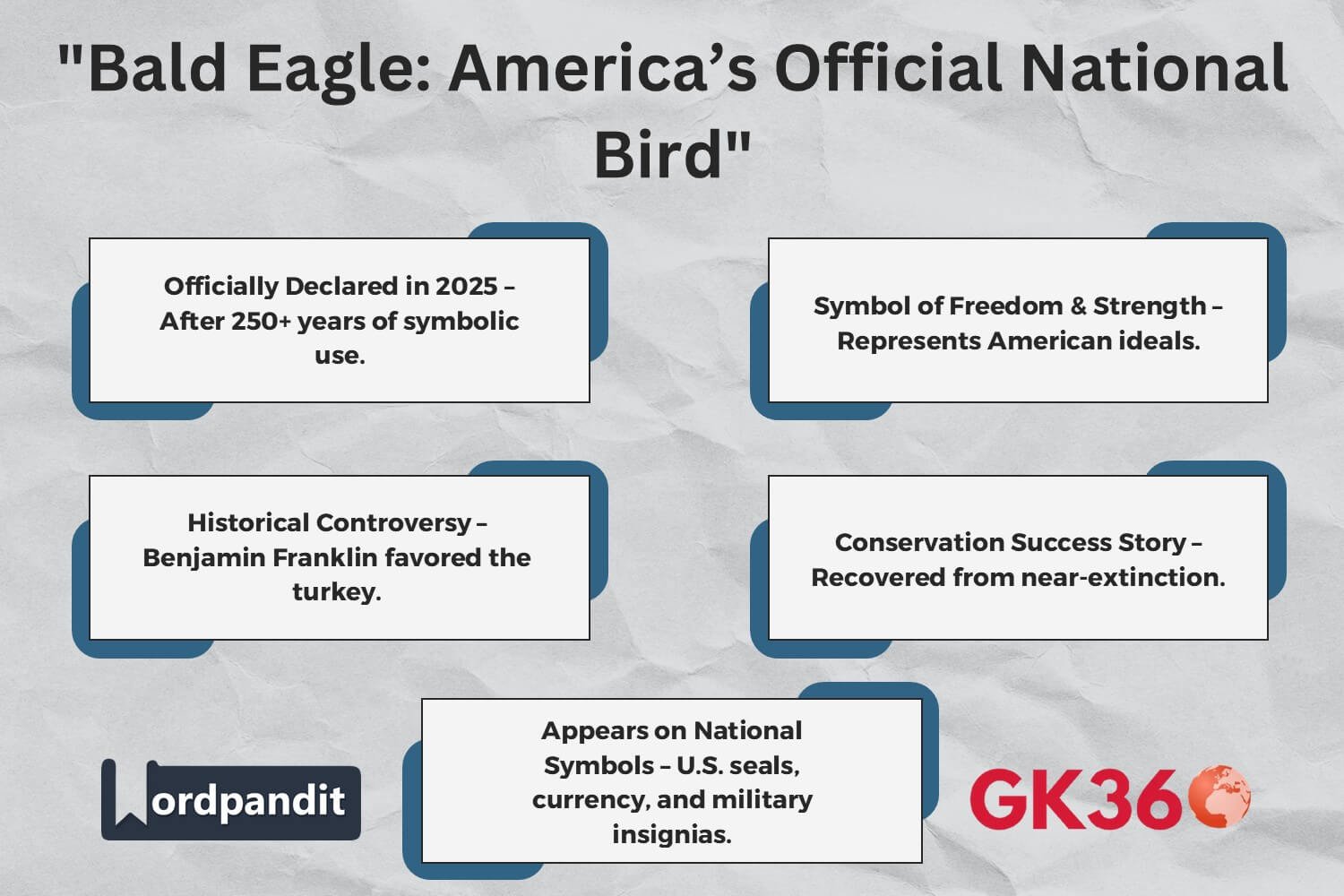The Bald Eagle Becomes America’s National Bird: History & Significance
Introduction
The United States has officially declared the bald eagle as its national bird, marking a historic milestone that aligns with the country’s values, heritage, and conservation achievements. After more than 250 years of symbolic representation, this formal recognition cements the bald eagle’s status as an enduring emblem of American strength and resilience.

Table of Contents
- Introduction
- Why the Bald Eagle? The Symbolism Behind the Decision
- Historical Background: A 250-Year Journey to Recognition
- Conservation Success Story: How the Bald Eagle Was Saved
- Global Perspective: How Other Countries Choose National Birds
- Public Reaction: What Americans Think About the Declaration
- FAQs About the Bald Eagle’s National Status
- Conclusion: A Symbol of Strength, Freedom, and Conservation
Why the Bald Eagle? The Symbolism Behind the Decision
The bald eagle has long represented freedom, power, and resilience. Native to North America, it has been a central figure in American culture since the country’s founding. With its distinctive white head, powerful wingspan, and fierce gaze, the bald eagle embodies the spirit of independence and courage.
Prominently featured on American seals, coins, and military insignias, the bald eagle has long been associated with the nation’s ideals. Despite this historical prominence, no official declaration had been made until now, making this recognition a significant moment in American history.
Historical Background: A 250-Year Journey to Recognition
The bald eagle was first proposed as the national bird in 1782 when it was featured on the Great Seal of the United States. However, it was never formally declared as such. One of the biggest critics of this choice was Founding Father Benjamin Franklin, who argued that the turkey would have been a better representation of American character, calling the bald eagle a bird of “bad moral character.”
Despite the debates, the bald eagle became an unofficial symbol of the U.S., appearing in government insignias, military banners, and patriotic artwork. This 2025 declaration finally solidifies its role as the nation’s official bird.
Conservation Success Story: How the Bald Eagle Was Saved
The bald eagle not only represents national pride but also serves as a conservation success story. In the mid-20th century, the species faced near-extinction due to habitat destruction, hunting, and the widespread use of the pesticide DDT. By the 1960s, the bald eagle was classified as endangered.
Thanks to protective legislation such as the Endangered Species Act of 1973 and the banning of DDT, the bald eagle population rebounded dramatically. In 2007, the species was officially removed from the endangered species list, symbolizing America’s dedication to environmental stewardship and wildlife protection.
Global Perspective: How Other Countries Choose National Birds
The U.S. is not alone in designating a national bird. Many countries have selected birds that reflect their culture and natural heritage:
- India: The peacock symbolizes beauty, grace, and cultural pride.
- Japan: The green pheasant represents elegance and vitality.
- New Zealand: The kiwi, a flightless bird, signifies uniqueness and biodiversity.
This global tradition underscores the role of birds in shaping national identity and cultural pride.
Public Reaction: What Americans Think About the Declaration
The official announcement of the bald eagle as the national bird has received widespread support. Conservationists, historians, and the general public have embraced the decision, viewing it as a meaningful step in recognizing both the nation’s history and its commitment to wildlife protection.
Social media has been flooded with celebratory messages, with many praising the declaration as a bridge between America’s past and future. The bald eagle’s resurgence stands as a testament to the country’s conservation efforts and national pride.

FAQs About the Bald Eagle’s National Status
1. When was the bald eagle officially declared the national bird of the USA?
The bald eagle was officially declared the national bird in 2025 after more than two centuries of symbolic association with the country.
2. Why was the bald eagle chosen as the national bird?
It represents freedom, strength, and resilience—values deeply ingrained in American identity.
3. What was the controversy over the bald eagle as the national bird?
Benjamin Franklin opposed the choice, arguing that the turkey was a more noble bird and that the bald eagle exhibited scavenger-like behavior.
4. Was the bald eagle ever endangered?
Yes. Due to hunting, habitat destruction, and pesticide use, the bald eagle was nearly extinct in the 20th century. Conservation efforts helped restore its population.
5. What does the bald eagle symbolize in American history?
The bald eagle has been featured on the Great Seal of the U.S., military insignias, and currency, embodying national strength and freedom.
Conclusion: A Symbol of Strength, Freedom, and Conservation
The official recognition of the bald eagle as the United States’ national bird is more than a declaration—it is a celebration of heritage, resilience, and conservation success. As this majestic bird soars across North America, it remains a powerful emblem of the nation’s enduring values.
Key Takeaways Table
| Aspect | Details |
|---|---|
| National Bird | Bald Eagle (Declared in 2025) |
| Symbolism | Freedom, strength, and resilience |
| Historical Debate | Benjamin Franklin preferred the turkey |
| First Use in U.S. History | Featured on the Great Seal in 1782 |
| Endangered Status | 1960s-2007 due to hunting & DDT |
| Key Conservation Laws | Endangered Species Act, DDT Ban |
| Cultural Significance | Appears on currency, military insignias, & government seals |
Related terms
- Bald Eagle National Bird USA
- History of the Bald Eagle in America
- Bald Eagle Conservation Success
- Why the Bald Eagle Represents America
- Bald Eagle vs. Turkey National Bird Debate
- Benjamin Franklin on the Bald Eagle
- U.S. Wildlife Protection Laws
- Symbolism of the Bald Eagle
- Endangered Birds in America
- National Birds of the World





